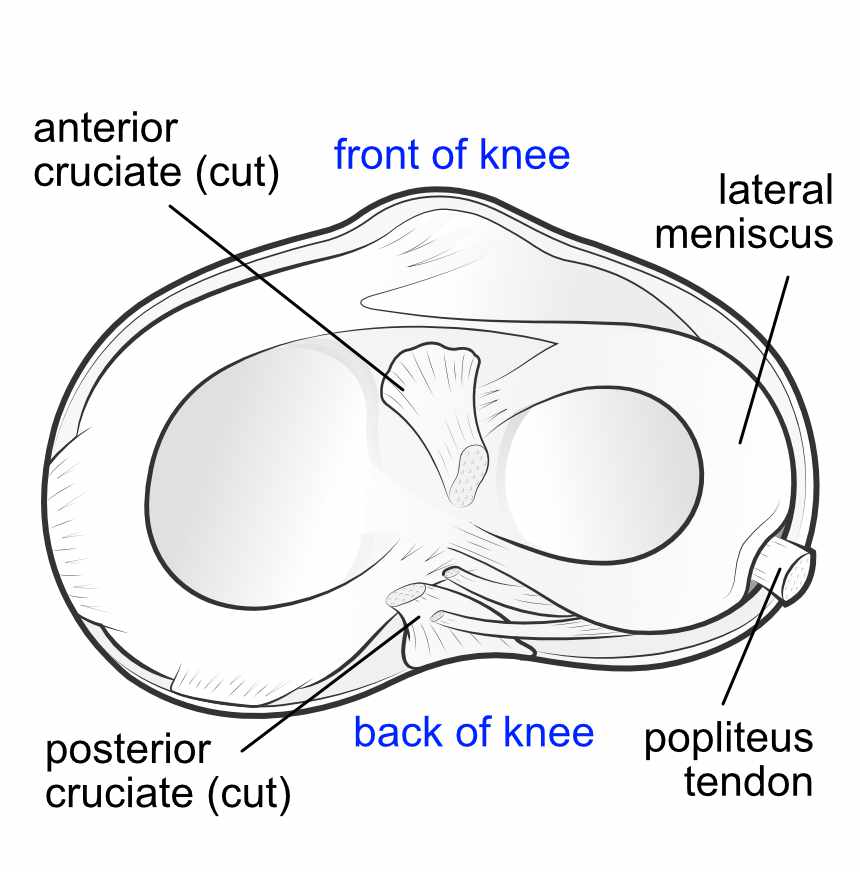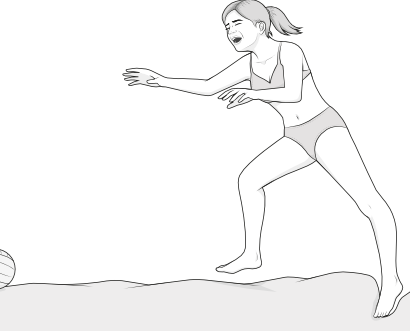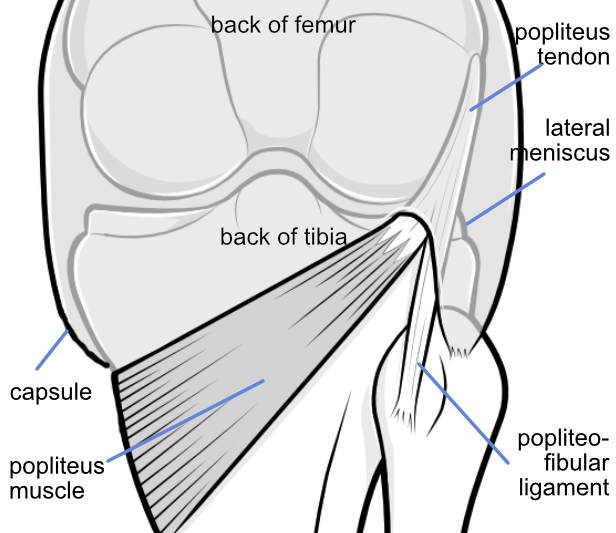The posterolateral corner is the region on the outer aspect of the knee, towards the back. The anatomy here is complex, and repair of any damage is the domain of only the expert surgeon.
 Page updated February 2024 by Dr Sheila Strover (Clinical Editor)
Page updated February 2024 by Dr Sheila Strover (Clinical Editor)

Looking down at the two menisci from above, you can see the tendon of the popliteus muscle passing between meniscus and capsule at the posterolateral corner.
What structures make up the posterolateral corner?
One of the key structures of the posterolateral corner is the popliteus muscle and its tendon. The muscle arises on the tibia bone and wraps around the back of the tibia to attach via its tendon on the outer aspect of the femur at the side of the knee joint. The popliteus tendon has an intimate relationship to the back of the lateral meniscus.
Important postero-lateral corner structures include:
- popliteus muscle and tendon
- popliteofibular ligament
- lateral collateral ligament (aka fibular collateral ligament)
- lateral meniscus
- posterior cruciate ligament
- arcuate ligament
These are important stabilisers of the outer part of the knee. The popliteus tendon is particularly important - if it is ruptured a careful surgeon should be able to see this during arthroscopy.
What are the symptoms of a posterolateral corner injury?
Damage to the posterolateral corner may lead to instability, with the knee joint thrusting outwards with each step (lateral thrust).
What is the usual mechanism of injury of the posterolateral corner?

Injury to the posterolateral corner is usually the result of an impact, especially if the knee is hyper-extended (bent backwards).
In this 'pothole' example there is no impact, but momentum carries the person forward and the person's foot cannot follow, leading to knee hyperextension.
Usually there is an associated injury to the anterior or posterior cruciate ligament (ACL or PCL). In that case, repair of these two ligament injuries may fail unless the surgeon also addresses damage to other posterolateral corner structures.
Why is reconstruction of the posterolateral corner so challenging?
- This region of the knee is inherently unstable. When PLC damage is associate with cruciate ligament tears, failure to stabilise the PLC may lead to failure of the cruciate ligament reconstruction.
- The full diagnosis may only have been appreciated months after the injury and often long after cruciate ligament reconstruction.
- The anatomy is challenging. For example the popliteus muscle is outside the joint capsule but its tendon attaches within the joint capsule.
- In challenging cases stability may be improved with a slope-changing osteotomy.
Quick links
Forum discussions
- Success rates on Posterolateral Corner Reconstructions
Many valuable discussions about rehab after posterolateral corner surgery.
Peer-reviewed papers
-
Quote:
"...injuries to the posterolateral corner...[are] present in almost 16% of all knee injuries and are responsible for sustained instability and failure of concomitant reconstructions if not properly recognized."
Citation: Crespo B, James EW, Metsavaht L, LaPrade RF. Injuries to posterolateral corner of the knee: a comprehensive review from anatomy to surgical treatment. Rev Bras Ortop. 2014 Dec 24;50(4):363-70. doi: 10.1016/j.rboe.2014.12.008. PMID: 26401495; PMCID: PMC4563052.
-
Quote:
"...the PLC (is) often...labelled as the ‘dark side’ of the knee...a standardized algorithm for the diagnosis and treatment of the PLC is still lacking, and much controversy remains...Treatment decisions should be made on a case-by-case basis."
Citation: Figueroa F, Figueroa D, Putnis S, Guiloff R, Caro P, Espregueira-Mendes J. Posterolateral corner knee injuries: a narrative review. EFORT Open Rev. 2021 Aug 10;6(8):676-685. doi: 10.1302/2058-5241.6.200096. PMID: 34532075; PMCID: PMC8419800.
Relevant material -
- Lateral meniscus
- Popliteus tendon
- Popliteus muscle
- Popliteo-fibular ligament
- Lateral collateral ligament
- Posterior cruciate ligament
- Arcuate ligament
- Popliteo-meniscal fascicles
- Triple varus
- Dial test
 Course - 2009 - Posterolateral corner injuries of the knee - by Dr Frank R Noyes (Knee Surgeon)
Course - 2009 - Posterolateral corner injuries of the knee - by Dr Frank R Noyes (Knee Surgeon)
Peer-reviewed content -
- 2004 - The posterolateral corner of the knee. Anatomy, biomechanics and management of injuries. - Authored by Davies H. et al. and summarised for you by Dr Sheila Strover (Clinical Editor)
